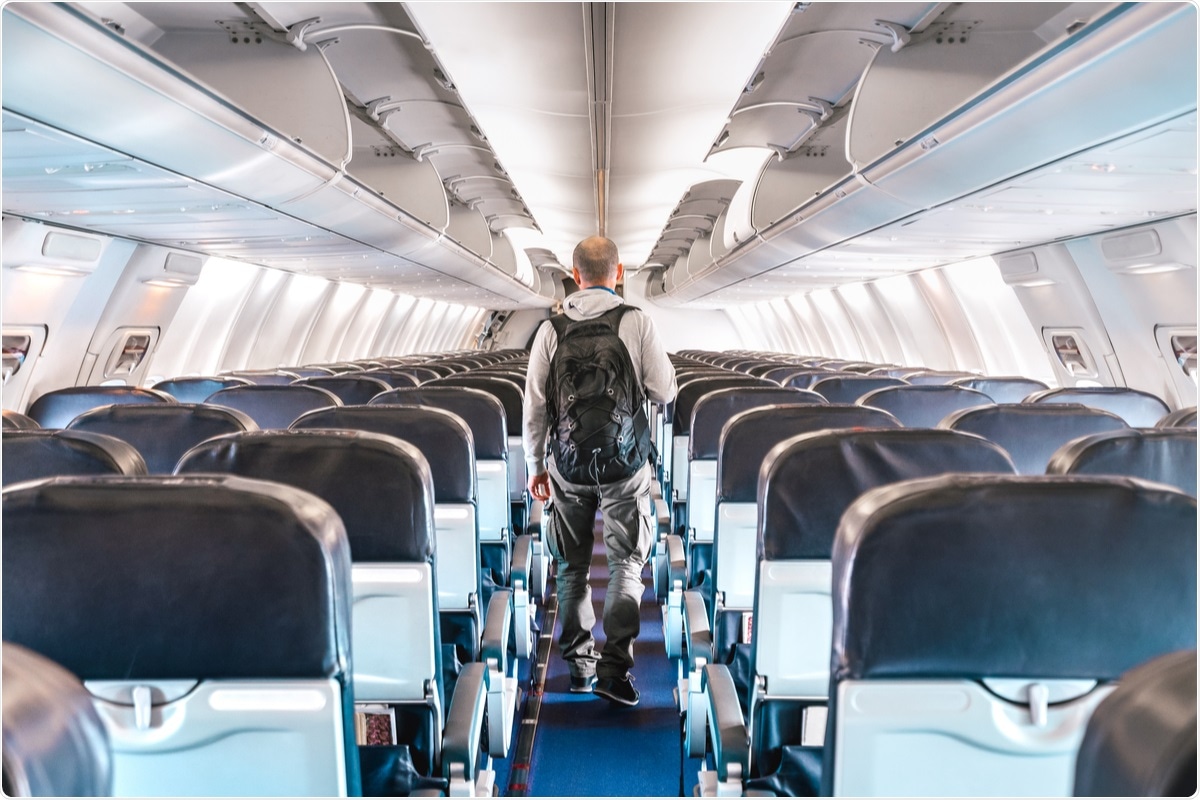Several outbreaks, including SARS, measles, influenza, and tuberculosis, have occurred during air travel. During the ongoing coronavirus disease 2019 (COVID-19) pandemic, concern over outbreaks has caused a sharp decline in air travel, and passenger traffic was estimated to be 44–59% less than normal in 2020. Airlines have implemented several procedural changes in response to the pandemic. Two important changes include a decrease in occupancy by leaving the middle seat empty and boarding procedure changes.
Delta Airlines, for instance, introduced a modified boarding procedure, where boarding starts from the last row of the plane, with business class passengers still boarding first. United Airlines boards back-to-front rows with business class boarding last. The back-to-front boarding trend is intended to decrease the likelihood of passengers passing others while walking toward or taking their seats.

Studies show that back-to-front boarding process may not reduce social proximity
Although the back-to-front boarding process is slower than the other processes, airlines believe that decreased social proximity would lead to a decline in exposure to viruses, which will help reduce the risk of outbreak inflight.
Many studies report that back-to-front boarding process may not reduce social proximity. In previous works, analyzing the risk of SARS and Ebola outbreaks during boarding of planes, it was observed that this new process did not decrease the clustering of passengers while waiting for others to stow their baggage. This had a considerable impact on increasing the risk of infection. This clustering increases with an increase in zones in contiguous sections of the plane.
Back-to-front boarding is equivalent to one zone per row and can thus lead to increased clustering and exposure to the pathogen. Hence, there is a need for a better understanding of the impact of boarding process changes on exposure to the virus.
Simulating boarding processes to assess their impact on social proximity
In a study published in the Royal Society Open Science journal, researchers simulated many boarding processes to assess their impact on social proximity during boarding. They also studied the dominant mechanisms by which these processes generate social proximity. The researchers systematically measured proximity by measuring the number of contacts originating from the following situations:
1. contacts between seated passenger pairs; 2. contacts between aisle passenger pairs; and 3. contacts between a seated passenger and an aisle passenger.
Back-to-front boarding process increases proximity between seated and aisle passengers
The results of the study show that while a back-to-front boarding process does reduce exposure of seated passengers to those passing them toward their seats, this process increases proximity between pairs of passengers in the aisle and pairs of seated passengers.
Hence, the net impact is an increase in exposure by about 100% compared to random boarding. This boarding process also increases exposure to the virus by around 50% compared to a typical pre-pandemic boarding process. Although a change in the boarding process during the pandemic did not decrease exposure, leaving middle seats empty was shown to lead to a substantial decrease in exposure to the virus.
Boarding window seats before aisle seats and banning the use of overhead bins can decrease exposure risk
To summarize, the findings suggest that back-to-front boarding process roughly doubles exposure and infection risk compared to the pre-COVID-19 boarding process followed by airlines. They can reduce infection risk better using the random boarding process. While the original boarding procedures were worse than they could have been, the new boarding processes further worsen the risk of infection by increasing social proximity.
The study also shows that boarding of window seats before aisle seats and prohibiting the use of overhead bins to stow baggage can also lead to a substantial decrease in exposure and infection risk. Additionally, different boarding processes have similar strengths in keeping middle seats empty to reduce exposure.
Scientific changes to boarding practices can substantially reduce COVID-19 infection risk by increasing social distancing. The researchers are next working on a close-range infection transmission model that will enable actual infection risk estimation.
The researchers conclude:
Our results suggest that the new boarding procedures increase the risk of exposure to COVID-19 compared with prior ones and are substantially worse than a random boarding process.”
- Islam T., Lahijani M. Sadeghi, Srinivasan A., Namilae S., Mubayi A. and Scotch M. 2021From bad to worse: airline boarding changes in response to COVID-19R. Soc. open sci.8201019201019. doi: http://doi.org/10.1098/rsos.201019, https://royalsocietypublishing.org/doi/10.1098/rsos.201019
Posted in: Medical Science News | Medical Research News | Miscellaneous News | Disease/Infection News | Healthcare News
Tags: Coronavirus, Coronavirus Disease COVID-19, Epidemiology, Influenza, Measles, Pandemic, Pathogen, SARS, SARS-CoV-2, Tuberculosis, Virus, Walking

Written by
Susha Cheriyedath
Susha has a Bachelor of Science (B.Sc.) degree in Chemistry and Master of Science (M.Sc) degree in Biochemistry from the University of Calicut, India. She always had a keen interest in medical and health science. As part of her masters degree, she specialized in Biochemistry, with an emphasis on Microbiology, Physiology, Biotechnology, and Nutrition. In her spare time, she loves to cook up a storm in the kitchen with her super-messy baking experiments.
Source: Read Full Article
